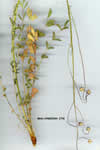| Rosaceae |
|---|
Sanguisorba L. |
S. minor Scop., Fl. Carn. 110 (1772). Figure 1, p. 87. Stems erect, (5-) 10-75 cm, glabrous, puberulous or sparsely pilose, sparingly branched. Lower leaves in rosettes at the base of the stems, ± oblong, pinnate with (7-) 11-17 orbicular to oblong to ovate, deeply serrate leaflets, usually pilose or sericeous-pilose beneath. Upper leaves few, similar to rosette leaves but with fewer, relatively narrower leaflets. Heads ± globose. Sepals green with whitish or pinkish margins, ovate-oblong, 2-3 mm. Hypanthium forming a hard, nut-like 4-angled fruit with hairy, wrinkled or verrucose faces. A very variable species which Nordborg divides into 6 subspecies, definable on fruit characters, which are not correlated with any other vegetative or floral features. Of the 6 subspecies, 4 occur in Turkey. 1. Fruit puberulous, obovoid or ovoid, rounded to the apex, not compressed, the 4 wings obscure, the surface wrinkled or almost smooth, 2-3 x 1-1.5 mm (Figure 1) . subsp. lasiocarpa 1. Fruit glabrous, rounded or ± acute at the apex, compressed or not, wings often conspicuous, surface usually conspicuously wrinkled or verrucose, 2.5-4 x 1.3 mm 2. Angles not prominently winged, rather flattened; fruit fusiform, somewhat compressed, surface wrinkled, 3-3.7 x 1-1.5 mm (Figure 1) subsp. minor 2. Angles prominently winged, or if not, fruit markedly verrucose with conspicuous projections, not flattened, ovoid to obovoid 3. Surface of fruit thrown into coarse folds and wrinkles; fruit 3-4 x1.6-2.5 mm (Figure 1) subsp. muricata 3. Surface of fruit drawn up into prominent projections; fruit 3.5-4.5 x 2-3 mm (Figure 1) subsp. magnolii subsp. lasiocarpa (Boiss. & Hausskn.) Nordb. in Op. Bot. (Lund) 11:66 (1966). Syn: Poterium villosum Sm. in Sibth. & Sm., Prodr. F1. Graec. 2:238 (1816); P. lasiocarpum Boiss. & Hausskn. in Boiss., F1. Or. 2:733 (1872); Sanguisorba lasiocarpa (Boiss. & Hausskn.) Hand.-Mazz. in Ann. Nat. Hofmus. Wien 27:67 (1913). Ft: 7-9. Damp meadows, stream sides, 300-2400 m. Lectotype: [Iran] ad Bebehan Persiae australis, Haussknecht (G, fide Nordborg 1967). N.W., C. & E. Anatolia. A2(A) Balikesir: Marmaris Adasi, A. Baytop 13644! B3 Eskişehir: Kopet Da., Nordborg 8110. B7 Sivas: Divriği, 1200 m, Sorger 70-31-27! B8 Bitlis: Meleto Da., Sassun, 1500-2400 m, Hand.-Mazz. 2782! B9 Bitlis: Pelli Da., 1900 m, D. 46041! C7 Urfa: 11 km W. of Ceylanpinar, 300 m, Hub.-Mor. 15122. C8 Mardin: Mardin, Sint. 1888:1104! C9 Hakkari: Zap gorge, 55 km S. of Başkale, D. 23844! C10 Hakkari: 10 km from Yüksekova, Gevar Ovasi, 1950 m, Duncan & Tail 148! Italy, Greece, S.W. Asia. Nordborg reports 2» = 56 for 2 Turkish collections from Istanbul (Aydos Da.) and Eskişehir (Kopet Da.). Intermediates occur between all the subspecies. These are fully discussed by Nordborg (1967), who also gives a complete set of illustrations and distribution maps. The following records are from Provinces or Squares for which. there are no records of the individual subspecies but from which flowering material (that cannot be identified to subspecies) is known: A1(E) Tekirdağ: Tekirdağ to Malakara, 3-50 m, D. 34690! A2(A) Bilecik: 2 km S. of Bilecik station, 400 m, D. 42076! A5 Yozgat: Akdağmadeni to Büyük Nalbant Da., 1800 m, Coode & Jones 2093! Samsun: Samsun, 5 m, Tobey 260! A7 Gümüşane: Tegrulun Köprü, Basi Köy, 950 m, Tobey 201! A8 Çoruh: Borçka, 200 m, Stainton 8205! B2 Manisa: Salihli, 800 m, Coode & Jones 2809! B7 Diyarbakir: 5 km N. of Ergani, 1000 m, D. 29012! B7 Tunceli: Tunceli to Pülümür, 1100 m, D. 29231! |
 NORDB_jpg.jpg)

